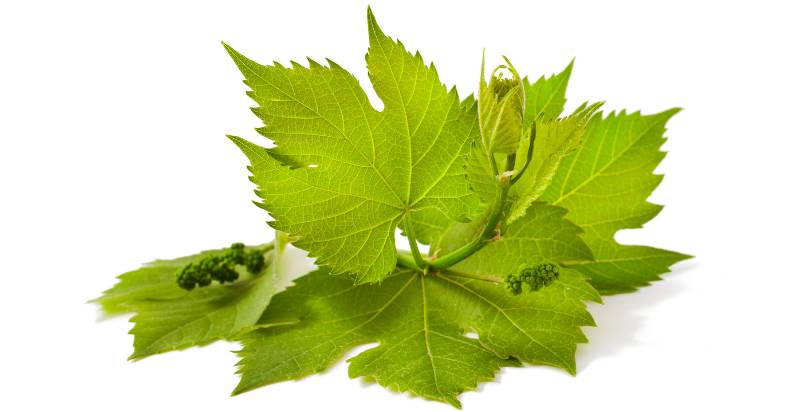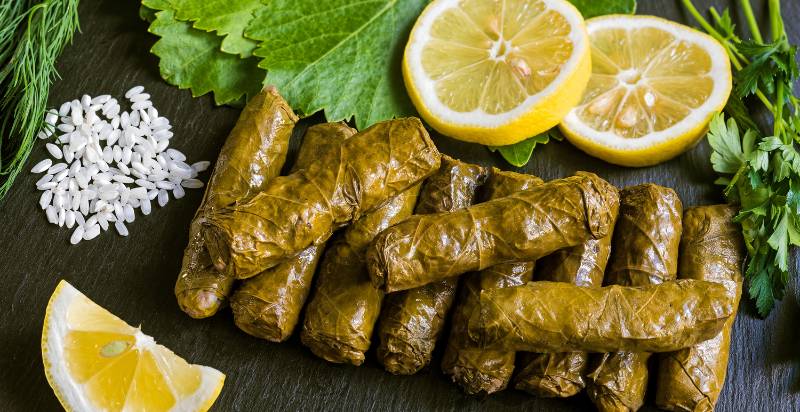Grape leaves are the edible leaves of the grapevine and have been used for centuries in traditional dishes around the world. They are a popular ingredient in Mediterranean cuisines and North African, Middle Eastern, and Central Asian cuisine. They can be prepared fresh or pickled and enjoyed independently or as part of a dish.
Description / Taste:
Grape leaves are typically picked fresh and eaten raw, steamed, or boiled. The flavor of the leaves can vary depending on when they are harvested, but they generally have a sweet, grassy flavor that can range from mild to slightly bitter. When pickled with vinegar and spices, grape leaves taste tart and tangy.

Seasons / Availability:
Grape leaves are available year-round, but the peak season is June through August.
Geography / History:
Grape leaves have been used in cooking and medicine since ancient times. They are believed to have originated in Asia Minor, though they are now cultivated worldwide. In Greece, Turkey, and Lebanon, these are often used to wrap foods like fish or rice before being cooked.
Applications of Grape leaves:
Grape leaves can be used in a variety of ways. Natural grape leaves are often added to salads and sandwiches, while cooked or pickled grape leaves can accompany fish, lamb, poultry, and vegetables. They can also be stuffed with various fillings such as rice, meat, and vegetables. In addition to being used in food, these leaves are also believed to have medicinal properties and are used in many traditional medicines.
Nutritional Value of Grape Leaves:
Grape leaves are a good source of fiber, vitamins A and C, and minerals such as calcium and iron. They contain very few calories and are a great source of antioxidants.
Health Benefits:
Grape leaves are believed to have many health benefits, including aiding digestion, reducing inflammation, and improving cardiovascular health. They are also thought to help relieve symptoms of allergies and asthma. In addition, these leaves may have antibacterial and antiviral properties that can help fight infections.
Storage:
Fresh grape leaves should be stored in the refrigerator and used within a few days. Pickled grape leaves can be stored in an airtight container in the refrigerator for up to three months.
How to Use Grape Leaves?
Grape leaves can be used in a variety of dishes. Fresh leaves can be added to salads and sandwiches, while pickled or cooked grape leaves can accompany fish, lamb, poultry, and vegetables. They can also be stuffed with various fillings such as rice, meat, and vegetables.
Grape leaves can also wrap fish and other ingredients before cooking. In addition, they can be boiled or steamed and enjoyed on their own with a sprinkle of olive oil, lemon juice, and herbs. These leaves are also believed to have medicinal properties and are used in many traditional medicines.

Recipes:
Grape leaves can be used in various recipes, from appetizers to main dishes. Some popular dishes include stuffed grape leaves, dolmas (rice and lentils wrapped in grape leaves), tabbouleh salad, and grape leaf and feta cheese rolls.
In Conclusion:
Grape leaves are a versatile and nutritious ingredient used in various dishes. They have long been a staple in Mediterranean cuisine but can also be used in other cuisines worldwide. In addition to being delicious, they are also believed to have many medicinal benefits. Whether you enjoy them raw or boiled, pickled or stuffed, grape leaves will surely add flavor and nutrition to your diet.
- Everything You Wanted to Know About Red Tamarillos - June 2, 2025
- A Guide to Tulips: Everything You Need to Know & More… - June 2, 2025
- Guanabana: Description, Flavor, Benefits, And Uses - May 27, 2025
